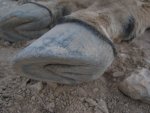Stratosphere
New User
Horse had laminitis last year, regular xrays have shown an improvement in rotation however the sole depth is currently only 1cm, vet has recommended shoes to help improve this, however horse has always been barefoot and I’d prefer to keep shoes off, obviously if shoes are the best thing for it then I will go ahead and instruct the farrier, I’m just hesitant to put shoes on, I’m rather in the barefoot camp!
Horse is currently on soaked hay, unmollassed balancer, hoof supplement (from vet) and magnesium, turn out is a bare field - essentially minimum sugar diet really.
So I guess my question is, what can I do to improve the sole depth without shoes?
Horse is currently on soaked hay, unmollassed balancer, hoof supplement (from vet) and magnesium, turn out is a bare field - essentially minimum sugar diet really.
So I guess my question is, what can I do to improve the sole depth without shoes?

